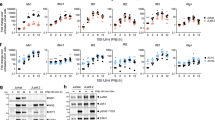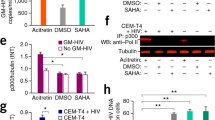Abstract
The β-galactoside-binding protein Galectin-9 (Gal-9) functions as a double-edged sword during HIV infection. On the one hand, Gal-9 can reactivate HIV latently infected cells, the main barrier to achieving HIV eradication, making them visible to immune clearance. On the other hand, Gal-9 induces latent HIV transcription by activating T cell Receptor (TCR) signaling pathways. These signaling pathways induce undesirable pro-inflammatory responses. While these unwanted responses can be mitigated by rapamycin without impacting Gal-9-mediated latent HIV reactivation, this effect raises the concern that Gal-9 may play a role in the chronic immune activation/inflammation that persists in people living with HIV despite antiretroviral therapy. Together, these data highlight the need to understand the positive and negative impacts of galectin interactions on immunological functions during HIV infection. In this chapter, we describe methods that can be used to investigate the effects of galectins, in particular Gal-9, on latent HIV transcription in vitro and ex vivo.
Access this chapter
Tax calculation will be finalised at checkout
Purchases are for personal use only
Similar content being viewed by others
References
Wong JK, Hezareh M, Gunthard HF, Havlir DV, Ignacio CC, Spina CA, Richman DD (1997) Recovery of replication-competent HIV despite prolonged suppression of plasma viremia. Science 278(5341):1291–1295
Finzi D, Hermankova M, Pierson T, Carruth LM, Buck C, Chaisson RE, Quinn TC, Chadwick K, Margolick J, Brookmeyer R, Gallant J, Markowitz M, Ho DD, Richman DD, Siliciano RF (1997) Identification of a reservoir for HIV-1 in patients on highly active antiretroviral therapy. Science 278(5341):1295–1300
Wandeler G, Johnson LF, Egger M (2016) Trends in life expectancy of HIV-positive adults on antiretroviral therapy across the globe: comparisons with general population. Curr Opin HIV AIDS 11(5):492–500. https://doi.org/10.1097/COH.0000000000000298
Rodger AJ, Lodwick R, Schechter M, Deeks S, Amin J, Gilson R, Paredes R, Bakowska E, Engsig FN, Phillips A, Insight Smart ESG (2013) Mortality in well controlled HIV in the continuous antiretroviral therapy arms of the SMART and ESPRIT trials compared with the general population. AIDS 27(6):973–979. https://doi.org/10.1097/QAD.0b013e32835cae9c
Barrera C, Espejo R, Reyes VE (2002) Differential glycosylation of MHC class II molecules on gastric epithelial cells: implications in local immune responses. Hum Immunol 63(5):384–393
de Freitas Junior JC, Silva Bdu R, de Souza WF, de Araujo WM, Abdelhay ES, Morgado-Diaz JA (2011) Inhibition of N-linked glycosylation by tunicamycin induces E-cadherin-mediated cell-cell adhesion and inhibits cell proliferation in undifferentiated human colon cancer cells. Cancer Chemother Pharmacol 68(1):227–238. https://doi.org/10.1007/s00280-010-1477-8
Dwek RA, Butters TD, Platt FM, Zitzmann N (2002) Targeting glycosylation as a therapeutic approach. Nat Rev Drug Discov 1(1):65–75. https://doi.org/10.1038/nrd708
Walt D, Aoki-Kinoshita KF, Bendiak B, Bertozzi CR, Boons GJ, Darvill A, Hart G, Kiessling LL, Lowe J, Moon R, Paulson J, Sasisekharan R, Varki A, Wong CH (2012) Transforming glycoscience: a roadmap for the future. National Academies Press, Washington
Mendez-Huergo SP, Blidner AG, Rabinovich GA (2017) Galectins: emerging regulatory checkpoints linking tumor immunity and angiogenesis. Curr Opin Immunol 45:8–15. https://doi.org/10.1016/j.coi.2016.12.003
Zhuo Y, Bellis SL (2011) Emerging role of alpha2,6-sialic acid as a negative regulator of galectin binding and function. J Biol Chem 286(8):5935–5941. https://doi.org/10.1074/jbc.R110.191429
Barondes SH, Cooper DN, Gitt MA, Leffler H (1994) Galectins. Structure and function of a large family of animal lectins. J Biol Chem 269(33):20807–20810
Gordon-Alonso M, Hirsch T, Wildmann C, van der Bruggen P (2017) Galectin-3 captures interferon-gamma in the tumor matrix reducing chemokine gradient production and T-cell tumor infiltration. Nat Commun 8(1):793. https://doi.org/10.1038/s41467-017-00925-6
Smith LK, Boukhaled GM, Condotta SA, Mazouz S, Guthmiller JJ, Vijay R, Butler NS, Bruneau J, Shoukry NH, Krawczyk CM, Richer MJ (2018) Interleukin-10 directly inhibits CD8(+) T cell function by enhancing N-glycan branching to decrease antigen sensitivity. Immunity 48(2):299–312.e5. https://doi.org/10.1016/j.immuni.2018.01.006
Sehrawat S, Reddy PB, Rajasagi N, Suryawanshi A, Hirashima M, Rouse BT (2010) Galectin-9/TIM-3 interaction regulates virus-specific primary and memory CD8 T cell response. PLoS Pathog 6(5):e1000882. https://doi.org/10.1371/journal.ppat.1000882
Tandon R, Chew GM, Byron MM, Borrow P, Niki T, Hirashima M, Barbour JD, Norris PJ, Lanteri MC, Martin JN, Deeks SG, Ndhlovu LC (2014) Galectin-9 is rapidly released during acute HIV-1 infection and remains sustained at high levels despite viral suppression even in elite controllers. AIDS Res Hum Retrovir 30(7):654–664. https://doi.org/10.1089/AID.2014.0004
Jost S, Moreno-Nieves UY, Garcia-Beltran WF, Rands K, Reardon J, Toth I, Piechocka-Trocha A, Altfeld M, Addo MM (2013) Dysregulated Tim-3 expression on natural killer cells is associated with increased Galectin-9 levels in HIV-1 infection. Retrovirology 10:74. https://doi.org/10.1186/1742-4690-10-74
Lanteri M, Giordanengo V, Hiraoka N, Fuzibet JG, Auberger P, Fukuda M, Baum LG, Lefebvre JC (2003) Altered T cell surface glycosylation in HIV-1 infection results in increased susceptibility to galectin-1-induced cell death. Glycobiology 13(12):909–918. https://doi.org/10.1093/glycob/cwg110
Lhuillier C, Barjon C, Niki T, Gelin A, Praz F, Morales O, Souquere S, Hirashima M, Wei M, Dellis O, Busson P (2015) Impact of exogenous galectin-9 on human T cells: contribution of the T cell receptor complex to antigen-independent activation but not to apoptosis induction. J Biol Chem 290(27):16797–16811. https://doi.org/10.1074/jbc.M115.661272
Elahi S, Niki T, Hirashima M, Horton H (2012) Galectin-9 binding to Tim-3 renders activated human CD4+ T cells less susceptible to HIV-1 infection. Blood 119(18):4192–4204. https://doi.org/10.1182/blood-2011-11-389585
Schaefer K, Webb NE, Pang M, Hernandez-Davies JE, Lee KP, Gonzalez P, Douglass MV, Lee B, Baum LG (2017) Galectin-9 binds to O-glycans on protein disulfide isomerase. Glycobiology 27(9):878–887. https://doi.org/10.1093/glycob/cwx065
Abdel-Mohsen M, Chavez L, Tandon R, Chew GM, Deng X, Danesh A, Keating S, Lanteri M, Samuels ML, Hoh R, Sacha JB, Norris PJ, Niki T, Shikuma CM, Hirashima M, Deeks SG, Ndhlovu LC, Pillai SK (2016) Human galectin-9 is a potent mediator of HIV transcription and reactivation. PLoS Pathog 12(6):e1005677. https://doi.org/10.1371/journal.ppat.1005677
Siliciano JD, Siliciano RF (2013) HIV-1 eradication strategies: design and assessment. Curr Opin HIV AIDS 8(4):318–325. https://doi.org/10.1097/COH.0b013e328361eaca
Bullen CK, Laird GM, Durand CM, Siliciano JD, Siliciano RF (2014) New ex vivo approaches distinguish effective and ineffective single agents for reversing HIV-1 latency in vivo. Nat Med 20(4):425–429. https://doi.org/10.1038/nm.3489
Colomb F, Giron LB, Premeaux TA, Mitchell BI, Niki T, Papasavvas E, Montaner LJ, Ndhlovu LC, Abdel-Mohsen M (2019) Galectin-9 mediates HIV transcription by inducing TCR-dependent ERK signaling. Front Immunol 10:267. https://doi.org/10.3389/fimmu.2019.00267
Hunt PW, Martin JN, Sinclair E, Bredt B, Hagos E, Lampiris H, Deeks SG (2003) T cell activation is associated with lower CD4+ T cell gains in human immunodeficiency virus-infected patients with sustained viral suppression during antiretroviral therapy. J Infect Dis 187(10):1534–1543. https://doi.org/10.1086/374786
Hunt PW, Cao HL, Muzoora C, Ssewanyana I, Bennett J, Emenyonu N, Kembabazi A, Neilands TB, Bangsberg DR, Deeks SG, Martin JN (2011) Impact of CD8+ T-cell activation on CD4+ T-cell recovery and mortality in HIV-infected Ugandans initiating antiretroviral therapy. AIDS 25(17):2123–2131. https://doi.org/10.1097/QAD.0b013e32834c4ac1
Kaplan RC, Sinclair E, Landay AL, Lurain N, Sharrett AR, Gange SJ, Xue X, Hunt P, Karim R, Kern DM, Hodis HN, Deeks SG (2011) T cell activation and senescence predict subclinical carotid artery disease in HIV-infected women. J Infect Dis 203(4):452–463. https://doi.org/10.1093/infdis/jiq071
Kaplan RC, Sinclair E, Landay AL, Lurain N, Sharrett AR, Gange SJ, Xue X, Parrinello CM, Hunt P, Deeks SG, Hodis HN (2011) T cell activation predicts carotid artery stiffness among HIV-infected women. Atherosclerosis 217(1):207–213. https://doi.org/10.1016/j.atherosclerosis.2011.03.011
Niwa H, Satoh T, Matsushima Y, Hosoya K, Saeki K, Niki T, Hirashima M, Yokozeki H (2009) Stable form of galectin-9, a Tim-3 ligand, inhibits contact hypersensitivity and psoriatic reactions: a potent therapeutic tool for Th1- and/or Th17-mediated skin inflammation. Clin Immunol 132(2):184–194. https://doi.org/10.1016/j.clim.2009.04.012
Kumar AM, Borodowsky I, Fernandez B, Gonzalez L, Kumar M (2007) Human immunodeficiency virus type 1 RNA levels in different regions of human brain: quantification using real-time reverse transcriptase-polymerase chain reaction. J Neurovirol 13(3):210–224. https://doi.org/10.1080/13550280701327038
Chavez L, Kauder S, Verdin E (2011) In vivo, in vitro, and in silico analysis of methylation of the HIV-1 provirus. Methods 53(1):47–53. https://doi.org/10.1016/j.ymeth.2010.05.009
Jordan A, Bisgrove D, Verdin E (2003) HIV reproducibly establishes a latent infection after acute infection of T cells in vitro. EMBO J 22(8):1868–1877. https://doi.org/10.1093/emboj/cdg188
Bliss CI (1939) The toxicity of poisons applied jointly. Ann Appl Biol 26:585–615
Jiang G, Mendes EA, Kaiser P, Wong DP, Tang Y, Cai I, Fenton A, Melcher GP, Hildreth JE, Thompson GR, Wong JK, Dandekar S (2015) Synergistic reactivation of latent HIV expression by ingenol-3-angelate, PEP005, targeted NF-kB signaling in combination with JQ1 induced p-TEFb activation. PLoS Pathog 11(7):e1005066. https://doi.org/10.1371/journal.ppat.1005066
Laird GM, Bullen CK, Rosenbloom DI, Martin AR, Hill AL, Durand CM, Siliciano JD, Siliciano RF (2015) Ex vivo analysis identifies effective HIV-1 latency-reversing drug combinations. J Clin Invest 125(5):1901–1912. https://doi.org/10.1172/JCI80142
Acknowledgments
M.A.-M. is supported by NIH grants (R01 DK123733, R01 AG062383, R01 NS117458, R21 AI143385, R21 AI129636, and R21 NS106970), The Foundation for AIDS Research (amfAR) impact grant # 109840-65-RGRL, and W.W. Smith Charitable Trust grant # A1901.
Author information
Authors and Affiliations
Corresponding author
Editor information
Editors and Affiliations
Rights and permissions
Copyright information
© 2022 Springer Science+Business Media, LLC, part of Springer Nature
About this protocol
Cite this protocol
Adeniji, O.S., Giron, L.B., Abdel-Mohsen, M. (2022). Examining the Impact of Galectin-9 on Latent HIV Transcription. In: Stowell, S.R., Arthur, C.M., Cummings, R.D. (eds) Galectins. Methods in Molecular Biology, vol 2442. Humana, New York, NY. https://doi.org/10.1007/978-1-0716-2055-7_25
Download citation
DOI: https://doi.org/10.1007/978-1-0716-2055-7_25
Published:
Publisher Name: Humana, New York, NY
Print ISBN: 978-1-0716-2054-0
Online ISBN: 978-1-0716-2055-7
eBook Packages: Springer Protocols




